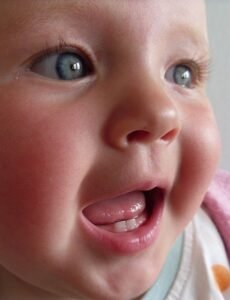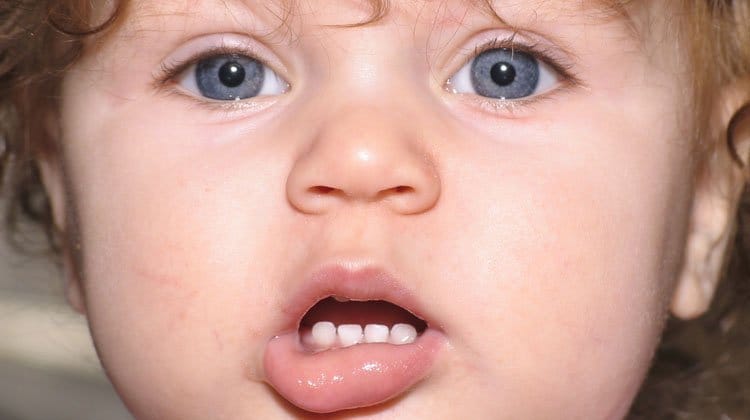Deciduous teeth or baby teeth (also known as milk teeth, or primary teeth) are as important as the permanent teeth. They help children early on with chewing and speaking. Even more important for that future charming smile, they save the space and develop the tooth gums for the primary teeth, thus guiding them in their proper position. If an early loss of baby teeth occurs, as a result of dental caries or injury, neighboring teeth can drift in the available space. This can lead to crooked and crowded teeth and bad eruption of the permanent teeth. That is why a bit of precaution in oral care while growing up can protect the teeth for decades to come and be the foundation of a glowing smile.
When do deciduous teeth appear?
Baby teeth come in between the sixth and the eight month. In the period between the second and the third year, children already have a formed set of 20 teeth, 10 on the upper and 10 on the lower jaw. These teeth play an important role in the oral and the general health of children and are present in children until the age of 12. During the 6th year, molars start erupting, and from the 7th to the 8th year, incisors appear as well. Between the 9th and 11th year, premolars and canines erupt, while at 12, the second set of molars appears. There is some variation between children, so do not be alarmed if your child does not follow the pattern, but consult a dentist, nonetheless.
Can they go bad?
Baby teeth have thinner layer of enamel and dentin and larger pulp chambers than permanent teeth. This makes them more susceptible to tooth decay and rooting. In the initial stage, children will not reveal symptoms of pain. As the illness advances, the teeth start to be sensitive when exposed to sweet and cold. The pain especially creeps in during eating, since food starts to enter the place of decay and starts pressuring the root canal and the tooth nerves.
When to start oral care?
 We all know how difficult it is to bring small children on the dental chair. That is one of the main reasons for the fast and frequent decay of baby teeth. Because of this, it is very important to start oral care since the eruption of the first teeth and to be diligent to avoid premature loss of baby teeth. If a tooth is lost, the space it occupied can be filled from a close by tooth by drifting, thereby closing the space. Because of this, the new tooth is not allowed to erupt normally and can grow inwards, or erupt from an irregular position. If this is the case, then tooth braces are unavoidable. If it happens that a baby tooth is lost or taken out prematurely, in order to save the space it occupies and hold the neighboring teeth in their original position, dentists recommend using fixed and moving holders, which are placed in the position of the lost/removed tooth.
We all know how difficult it is to bring small children on the dental chair. That is one of the main reasons for the fast and frequent decay of baby teeth. Because of this, it is very important to start oral care since the eruption of the first teeth and to be diligent to avoid premature loss of baby teeth. If a tooth is lost, the space it occupied can be filled from a close by tooth by drifting, thereby closing the space. Because of this, the new tooth is not allowed to erupt normally and can grow inwards, or erupt from an irregular position. If this is the case, then tooth braces are unavoidable. If it happens that a baby tooth is lost or taken out prematurely, in order to save the space it occupies and hold the neighboring teeth in their original position, dentists recommend using fixed and moving holders, which are placed in the position of the lost/removed tooth.
Can the teeth become rotten right after their appearing?
Sometimes, right after the eruption, we can notice brown spots on the baby teeth, and soon afterwards these teeth can brake and fall off. The main reason for this occurrence is the overuse of pacifiers. The main part of the baby’s diet is mother’s milk, and afterwards cow milk because it contains in itself natural sugars. Babies grow habit to hold milk in their mouths for increased periods of time. By doing this, bacteria which attack the teeth are formed in the mouth.
How to protect baby teeth?
You can help the protection of your child’s baby teeth by:
- Not allowing him/her to fall asleep with a pacifier in the mouth;
- Don’t add sugar, honey, biscuits or other sweeteners in the milk;
- After feeding, give your child water to drink, or wash the teeth if possible;
- Begin to clean your baby’s mouth early on after birth by wiping the gums with a clean, moist gauze pad or washcloth, since as soon as teeth appear, decay can occur;
- If your child is younger than 3 years, begin brushing his or her teeth as soon as they begin erupt by using fluoride toothpaste in an amount no more than a smear or the size of a grain of rice. Brush teeth thoroughly in the morning and before going to bed or as directed by a dentist. Always oversee children’s brushing and make sure they use the appropriate amount of toothpaste.
- For children between the ages of 3 and 6, use a pea-sized amount of fluoride toothpaste. Brush teeth thoroughly in the morning and before going to bed or as directed by a dentist. Continue to supervise children’s brushing and remind them not to swallow the toothpaste.
- Until you’re comfortable that your child can brush on his or her own, continue to brush your child’s teeth with a child-size toothbrush and the appropriate amount of fluoride toothpaste. When the child has two touching teeth, begin flossing their teeth daily.


